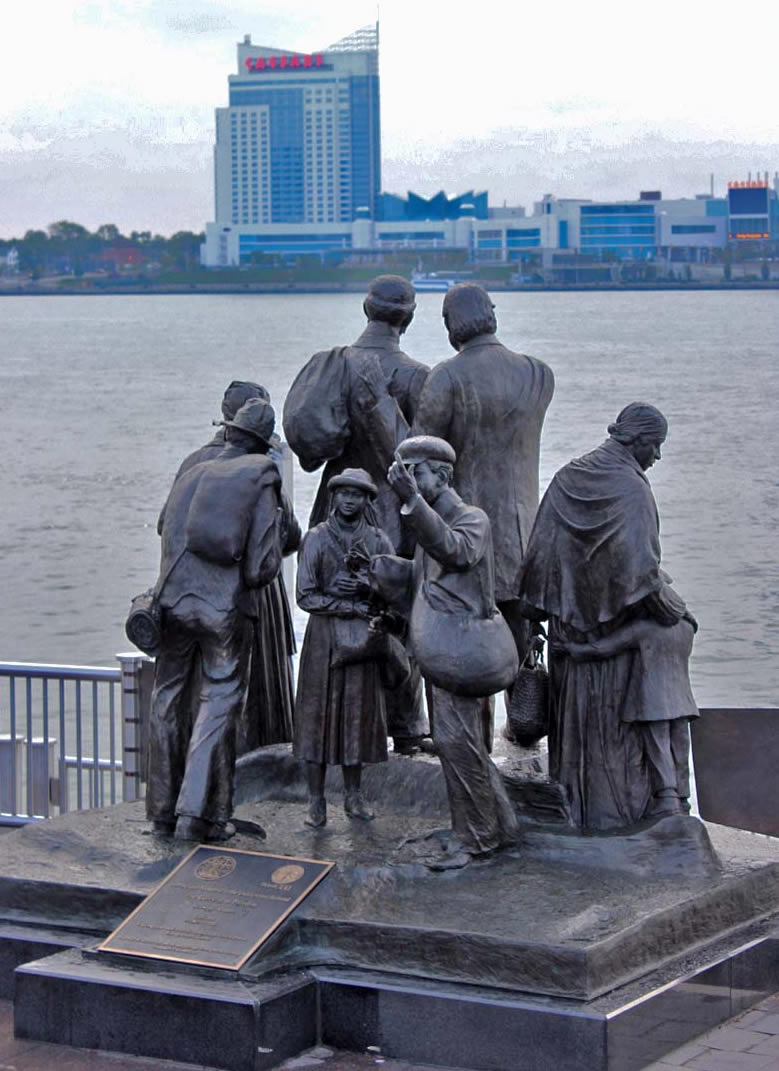 |
Photograph by Cara Stegler |
Statuary and Memorial Commemorating Detroit's Role in
the
Underground Railroad
at the Detroit River in Hart Plaza in downtown Detroit
The picture shows the Detroit installation of the International Memorial to the Underground Railroad erected in the year of the city's tercentennial. The companion monument by the same sculptor in Windsor is located on Pitt Street East near the Windsor Casino.
When Congress enacted the Northwest Ordinance in 1787 to establish a governmental system for the area that now includes Ohio, Indiana, Michigan, Illinois and Wisconsin; they declared that there shall neither be slavery nor involuntary servitude in the area. This was not interpreted to convey freedom upon slaves who were already living in the area or brought there by their masters. Indeed, censuses counted small numbers of slaves in Michigan. The last census to enumerate slaves in the state, 1830, counted 32.
In 1793, Upper Canada became the first area within the British Empire to abolish slavery. There were, of course, few slaves in the area now known as Ontario. And the 1793 act called for a gradual end to bondage since those held as slaves in that year would not be manumitted, but all of their offspring would be freed at age 25 and their children were free at birth. In addition, the act specified that no slaves could be imported to Upper Canada. Karolyn Smardz Frost, in her excellent book, I've Got a Home in Glory Land: A Lost Tale of the Underground Railroad (New York; Farrar, Straus and Giroux, 2007) reports that a few Canadian slaves emancipated themselves by escaping to Michigan.
The United States and Upper Canada had no formal extradition treaty, but in 1833, the parliament of Upper Canada, meeting in York—nowToronto—passed a Fugitive Offenders Act. Slaves from the United States fleeing to Canada could not be returned to bondage, but fleeing felons could be sent back. A few, perhaps several dozen or more, slave owners went to Canada, hired counsel, and sought the arrest and return of their property. They could not, of course, ask for the return of a slave, but many of those who escaped took a horse, money or other property from their masters. This allowed owners to request the return of a felon. In almost every case, lawyers working for the fugitive slaves successfully protected their clients. Smardz recounts the story of Jesse Happy, a Kentucky slave who stole a horse for his escape. His owner went to Canadian court to get an order for his return. However, his lawyer pointed out that Jesse Happy apparently felt bad about stealing the animal. When he got to Toledo, he boarded the horse and had a friend write to his owner telling him to pick up the horse. Canadian courts let him stay, arguing that he had not been convicted of a felony in Canada. One fugitive slave, John Anderson, was accused of killing a white man in Missouri as he escaped to Canada. US slave owners in Canada asserted a right to the return of a felon. Canadian courts and legal officials generally rejected such appeals contending that the fugitive, after punishment, would be returned to bondage. Frost, in the book cited previously, provides immense details about the complicated legal maneuvers used by slave owners in the Canadian courts. In almost all litigations, the fugitive slaves prevailed. John Anderson, for example, was allowed to remain in Canada.
Several routes of the Underground Railroad
went through Michigan. This statue commemorates the route through
Detroit. Another favorite crossing point was south of Detroit near
where Amherstburg, Ontario is located. This is, perhaps, the narrowest Point in the Detroit River. And by the mid-1830s, there was a modest population of former slaves living there who aided other to escape to freedom.
The sculpture in the United States, Gateway to Freedom, shows six fugitive
slaves
ready to board a boat to cross to Canada. The gentleman pointing from Detroit
to Windsor is George DeBaptist, a Detroit resident who helped slaves to get across
the river to freedom. The monument in Windsor features a former slave raising
his arms to celebrate his emancipation while a Quaker woman offers assistance
to a woman and her child. Another child in that monument looks back toward
Detroit. The
plaque associated with this monument mentions several Detroit institutions that
were active in the Underground Railroad and continue to serve the city's population
in the Twenty-first century: Bethel African-Methodist
Episcopal Church and
Second Baptist Church
Edward Dwight, a native of Kansas City, joined the Air Force in the early 1950s and became a test pilot. In 1961, President Kennedy appointed him to the training program for astronauts. He was the first African-America to qualify as an astronaut. I believe that he completed his military service in the early 1970s and devoted himself to sculpture. One of his early major pieces portrayed the first black man to serve as lieutenant governor of Colorado, George Brown. The statue of Hank Aaron at the Atlanta Braves baseball stadium was sculpted by Ed Dwight. A statue of Dr. Martin Luther King that he designed is in Denver's City Park. At the headquarters of the Kellogg Foundation in Battle Creek, you will find another sculpture by Ed Dwight—a memorial to the slaves who won their freedom by traveling the Underground Railroad. He won a competition to design the International Memorial to the Underground Railroad with the impressive statues on both sides of the Detroit River.
Sculptor: Ed Dwight
Date of Installation: 2001
Components: Granite and bronze
Website for the Sculptor, Ed Dwight: www.eddwight.com/home.htm
Use in 2009: Monument commemorating the escape of fugitive slaves to the freedom Canada.
Website describing the Underground Railroad in Michigan: http://www.albion.edu/library/JAT/summary.htm
Photograph: Ren Farley
Description: Updated November, 2011
Return to Public Art and Sculpture
Return to Racial History in Detroit
